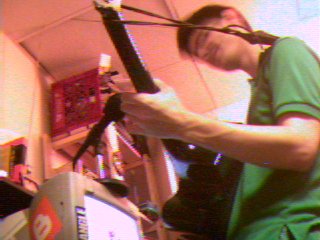From Copy Protection to Copy Protection, via AAA and a lot of chemistry that i very vaguely understand.
I’ve been alone in the house all day working on a paper on copy protection for my New Technologies in Communication class, and when Gina stopped by to say hello just after the second one a.m. she was only the third human i had spoken with all day . I was on a break from my paper at the time, sitting amidst a tangle of wires on the floor attempting to write a song in AAA form for my songwriting class. Gina inquired into this endeavor, and in my explanation of it i overstepped the bounds of simple differentiation between verse-chorus-verse, ABA, and AABACA to speculate on how song form effects the commercial prospects of an artists — perhaps dwelling on a day spent largely listening to Tori Amos.
I followed this idle chatter across our common area and into her room, by which point the conversation had switched over to inhabit a subject philisophically adjacent to the difference between Bob Dylan and Neil Young. Gina put on her new Donovan hits CD as i tooled around on my guitar in DADGCE, but the conversation eventually turned back to pop construction. After my obligatory monologue about the interrelation of image, genre, and songwriting Gina mentioned how pop music at least kept her awake and functioning during her grueling Saturday 7-hour laboratory class today. This particular exercise in weekly chemical punishment has become a favorite topic of ours, as Gina basically has eleven weeks to play a rousing game of “guess that organic compound” with the five seemingly random samples chosen for her by her instructor. I not only delight in the inherently game-show nature of this particular exercise, but also in the fun things Gina must do in her quest for knowlege.
One less than delightful thing Gina has to do in this quest for knowledge is use an array of photoscopic machinery to determine the nature of her compounds, rather than more traditional means like boiling things and making their colors change. However, Gina did all manner of machine-assisted processes at her co-op job, where she basically spent all day in a lab running reactions on organic polymers. After talking about several aspects of her employment, such as how she spent weeks getting a particular product to the ideal shade of “water white,” we finally came to rest on the benefits and similarities of ultraviolet and electron beam curing of… um… this thing that i’m going to ask Gina to name for me again when i wake up tomorrow morning. Basically, she was testing one element in the process that makes the wierd peely adhesive labels you find on plastic soda bottles, or the gloss and ink sealents on magazines.
This particular thread of conversation went on for a good long time, with several stop-overs for debates of when in their employment life-cycle a worker stops actively attaining/retaining knowledge of applicable technology and begins to merely sustain it. Coming back out of that, i attempted to make my understanding of electron beam curing more complete by asking what it would be more and less efficient to cure. Adhesive labels – good. Magazines – probably. Vinyl flooring – maybe not.
Consequently, Gina brought up that the sealants in questions were similar to those used on fiber-optic wire, which in turn sent me into a five minute discussion of fiber optics based on a presentation i saw in my New Technologies class this week. At the tail end of that it suddenly occured to me that the polycarbonate layer in the middle of a compact disc and the acrylic layer on the outside probably both made use of the chemical technology that Gina had been describing to me for the better part of two hours, and my mention of it lead into a brief overview of how a cd is put together. That in turn lead to an equally brief description of the differences between a CD and a CD-R, which in turn lead to a discussion of how CD-Rs are sometimes hard to read for older units but a cinch for CD-ROM drives. From there naturally headed into error correction and how CD-ROM technology error corrects more than a typical cd drive. And, before i knew what was happening, i was back at copy protection … explaining how sinister it was to corrupt the error correction of a disc to protect it from copying because it would degrade the overall lifespan of a disc.
I knew that extra hour would wind up being useful for something other than sleep.
